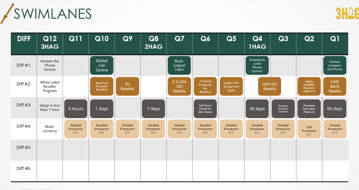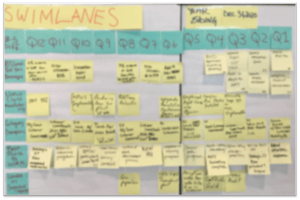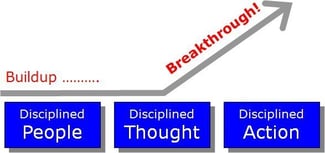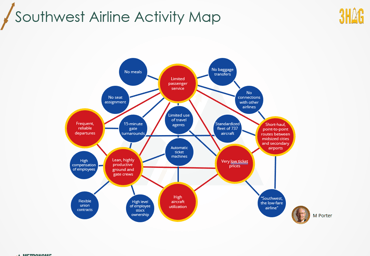 As the Cheshire cat told Alice, in Alice in Wonderland, “If you don’t know where you are going it doesn’t matter which road you take. Any road will get you there.”
As the Cheshire cat told Alice, in Alice in Wonderland, “If you don’t know where you are going it doesn’t matter which road you take. Any road will get you there.”
The trouble when making a 3-year plan is, without structure you don’t know where you are going.
More importantly, you want to be confident the path you are taking will get you there. Too much structure means no room for dynamic changes and flexibility. Too little and you don’t get there. The latter is particularly deadly since it provides the forecast the Cheshire cat gave Alice.
Your 3-Year Plan (our recommendation, a 3HAG – 3 Year Highly Achievable Goal) should have enough structure to give you confidence, and enough flexibility, that if market dynamics change you can adjust. In today’s marketplace, you can just about guarantee the market will change.
When You Know Where You’re Going, You Know You’re Great
In developing your 3HAG, building your swimlanes comes after you’ve mapped out your marketplace, determined what your company’s unique and valuable position will be within your marketplace, mapped your company internally, established who Your Core Customer is, and created a view of where you're positioned against your competitors(Key Attribution Framework).
This gives the leadership team a clear perspective on the company’s present and future and brings a powerful sense of clarity your team previously lacked.
“Confidence is contagious. So is lack of confidence.” —Vince Lombardi
Clarity turns into confidence, and confidence influences your entire team.
As Shannon notes in 3HAG WAY: The Strategic Execution System that ensures your strategy is not a Wild-Ass-Guess!, “Since strategic execution planning is an iterative process, you get better and sharper each time you convene back in your war room, and everyone feels the power of being confident about the company’s direction.”
SWIMLANES
 Shannon was able to sell her second company, Subserveo, quickly precisely because they accurately predicted in their first quarter where they would be in quarter twelve, thirty-six months away. Being able to predict where we will be three years out, and then advancing, quarter over quarter, to your goal shows buyers you know where you should be headed. It’s unique and valuable because it shows you can execute the steps needed to make our 3HAG a reality. This is exactly what building a 3HAG can achieve for your company too. Shannon’s team accurate predictions sent their company’s valuation through the roof. Buyers like predictability, teams like predictability, people like predictability. And predictability feeds directly into team confidence.
Shannon was able to sell her second company, Subserveo, quickly precisely because they accurately predicted in their first quarter where they would be in quarter twelve, thirty-six months away. Being able to predict where we will be three years out, and then advancing, quarter over quarter, to your goal shows buyers you know where you should be headed. It’s unique and valuable because it shows you can execute the steps needed to make our 3HAG a reality. This is exactly what building a 3HAG can achieve for your company too. Shannon’s team accurate predictions sent their company’s valuation through the roof. Buyers like predictability, teams like predictability, people like predictability. And predictability feeds directly into team confidence.
You want to have a 3HAG so you can easily explain the how: how exactly you’re going to execute your strategy now through the next twelve quarters.
 Once you’ve established your metrics for your 3HAG, you determine your 3-5 capabilities to achieve these targets. This takes a bit of work, and frequently the time and effort to do this while challenging is worth it. However, if you stop there you fail to get the true worth of your investment. You need to develop swimlanes, a 36-month, month-over-month rolling forecast.
Once you’ve established your metrics for your 3HAG, you determine your 3-5 capabilities to achieve these targets. This takes a bit of work, and frequently the time and effort to do this while challenging is worth it. However, if you stop there you fail to get the true worth of your investment. You need to develop swimlanes, a 36-month, month-over-month rolling forecast.
Swimlanes are project management processes and jargon. Any project you’re planning should have them.
Why would you not do this with the biggest and riskiest project you would ever face—your company? Have your leadership team take each of the 3-5 differentiators from the -1.png?width=355&name=Paradata%20Attribute%20Framework%20(Differentiators)-1.png) Key Attribution Framework and map out what it would look like to go from where you are today, quarter over quarter for twelve quarters, capturing the major milestones and assumptions.
Key Attribution Framework and map out what it would look like to go from where you are today, quarter over quarter for twelve quarters, capturing the major milestones and assumptions.
Then create a six-row by twelve-column grid on a wall and get some large sticky notes. Each row is a Swimlane for one of your differentiators; and in each quarter, add in the key milestones on a sticky note. Line this up for all your differentiators. Now you can see the whole path—the good, the bad, and the ugly. You need to achieve these key capabilities and differentiators. You now have the milestones or benchmarks clarified along the path to 3 years to reach them.
One best practice is to start with the end in mind. You can start with the 36th-month column in the very left hand or at the right hand, but either way, finish this column first. What’s your vision of what this will look like when you finally reach your 36-month goal?
In terms of your differentiators, developing your Activity Fit Map is another way to identify your benchmarks, by getting more granular on how you are going to achieve your differentiating actions.
We’ll share Activity Fit Maps with several examples next blog.
To create an environment where everyone is inspired to give their best, contact Positioning Systems today to schedule a free exploratory meeting.
Growth demands Strategic Discipline.
 Building an enduring great organization requires disciplined people, disciplined thought, disciplined action, superior results, producing a distinctive impact in the world.
Building an enduring great organization requires disciplined people, disciplined thought, disciplined action, superior results, producing a distinctive impact in the world.
Discipline sustains momentum, over a long period of time, laying the foundations for lasting endurance.
-2.jpg?width=271&name=3%20Disciplines%20of%20Execution%20(Strategic%20Discipline)-2.jpg) A winning habit starts with 3 Strategic Disciplines: Priority, Metrics, and Meeting Rhythms. Forecasting, accountability, individual, and team performance improve dramatically.
A winning habit starts with 3 Strategic Disciplines: Priority, Metrics, and Meeting Rhythms. Forecasting, accountability, individual, and team performance improve dramatically.
Meeting Rhythms achieve a disciplined focus on performance metrics to drive growth.
Let Positioning Systems help your business achieve these outcomes on the Four most Important Decisions your business faces:
|
DECISION |
RESULT/OUTCOME |
|
PEOPLE |
|
|
STRATEGY |
|
|
EXECUTION |
|
|
CASH |
|
Positioning Systems helps mid-sized ($5M - $250M) business Scale-UP. We align your business to focus on Your One Thing! Contact dwick@positioningsystems.com to Scale Up your business! Take our Four Decisions Needs Assessment to discover how your business measures against other Scaled Up companies. We’ll contact you.
 NEXT BLOG – Activity Fit Map – Trade-offs in Competing. What Not to Do.
NEXT BLOG – Activity Fit Map – Trade-offs in Competing. What Not to Do.
The Activity Fit Map allows you to lay out what should go in your swim lanes. Your Activity Fit Map challenges your ideas, provides great discussion in your leadership team, helping you determine what you should and shouldn’t compete on. We’ll explore Activity Fit Maps for Southwest Airlines and Ikea to help you understand the concept better in, next blog.






.jpeg?width=150&height=135&name=Hand%20with%20marker%20writing%20the%20question%20Whats%20Next_%20(1).jpeg)

